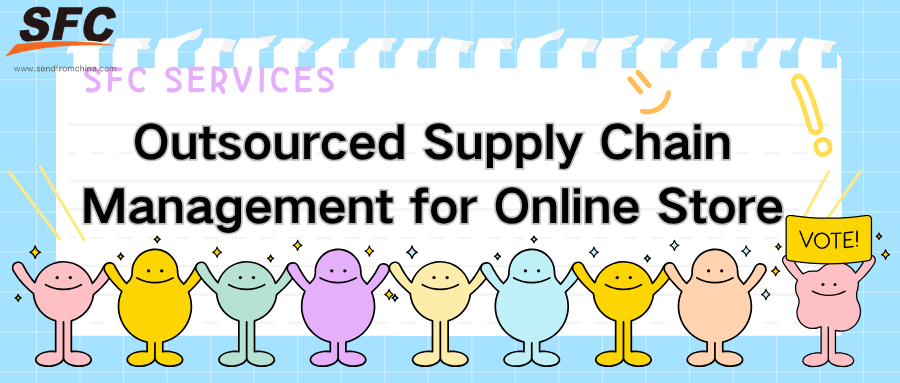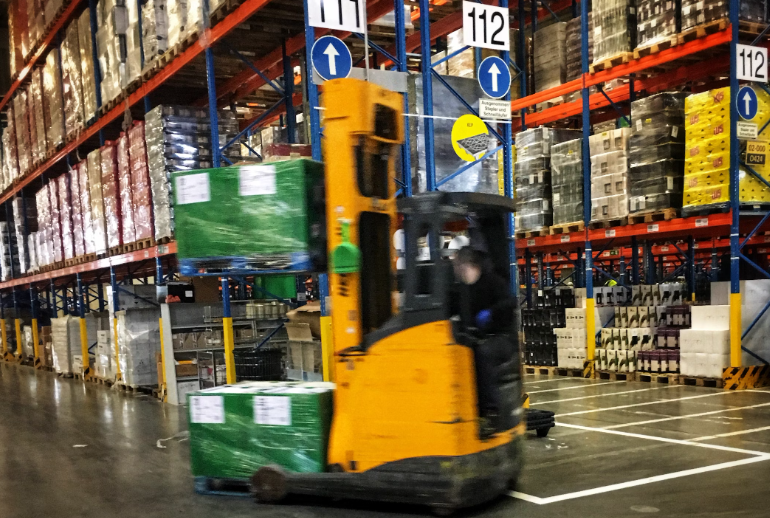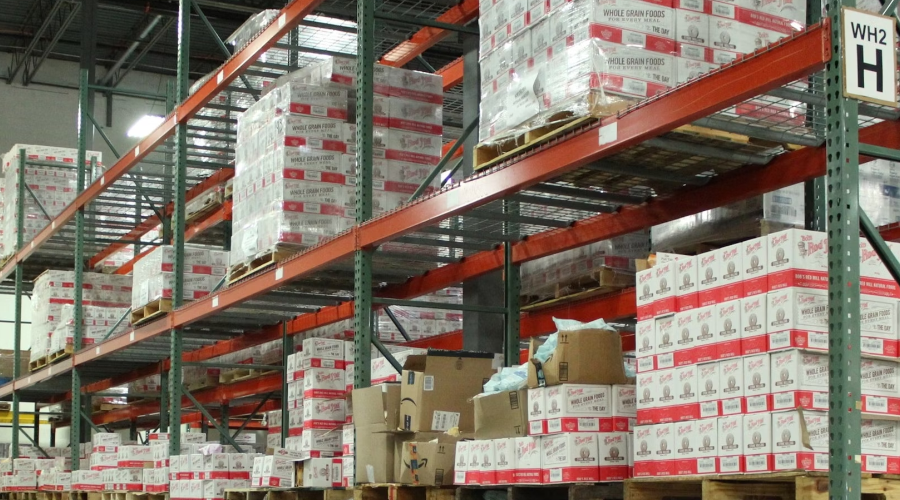Table of Contents
Get Custom eCommerce Fulfillment Service
Book a Meeting
Outsourced Supply Chain Management for Online Stores: Key Benefits & Risks
Time: Oct 16,2025 Author: SFC Source: www.sendfromchina.com
In the fast-paced world of ecommerce, managing your own supply chain end-to-end is increasingly challenging — from sourcing raw materials or products, overseeing manufacturing, handling international shipping, customs, warehousing, fulfillment, and reverse logistics. Many ecommerce brands reach a point where the operational overhead and complexity become a burden rather than a strength.

That’s where outsourced supply chain management comes in: entrusting parts or the entirety of your supply chain operations to specialized third-party providers.
1. What Is Outsourced Supply Chain Management
Outsourced supply chain management (SCM) refers to delegating some or all supply chain-related functions to external, specialized partners rather than doing everything in-house. In many cases, this involves working with third-party logistics (3PL) providers, or more broadly with providers that offer procurement, vendor management, planning, inventory, logistics, and after-sales services.
You may outsource only a slice of the operations (e.g. warehousing and fulfillment) or nearly the entire vertical, including procurement, quality control, customs, order delivery, and returns. This is sometimes called end-to-end supply chain outsourcing.
When done well, it means your business can operate more like a strategic orchestrator rather than being mired in logistics details.
Why It Matters for Ecommerce
Ecommerce businesses have a unique set of pressures:
Rapid growth fluctuations (e.g. holiday peaks, promotions)Need for fast fulfillment and reliable delivery
International complexity (customs, duties, tariffs)
High customer expectations for traceability, returns, and transparency
The cost burden of warehousing, labor, software, and shipping
By outsourcing supply chain functions, you can offload much of that complexity to specialists whose core competence is managing supply chains — letting you focus on marketing, product development, branding, and customer experience.
2. Benefits of Outsourced Supply Chain Management
Outsourcing your supply chain isn’t just about shifting burdens — it can bring real, tangible advantages. Below are some key benefits, supported by real-world observations and data.

Cost Savings and Efficiency Gains
One of the strongest drivers is cost reduction. A specialized partner typically operates at scale, with greater volume discounts, better freight rates, optimized route planning, and higher warehouse utilization.
You don’t need to invest heavily in infrastructure, software, staffing, or training. The partner already has those. You simply pay for the service.
Also, because logistics is their core business, they are likely to run leaner and more efficiently, reducing waste, delays, and idle capacity.
Focus on Core Competencies & Growth
By offloading supply chain tasks, your internal team can focus on value-added areas: product design, marketing, customer acquisition, service, and brand building. Many companies cite the benefit of “freeing up management bandwidth” as a top reason for outsourcing.
This shift from operational concerns to strategic focus can be a competitive differentiator in fast-moving markets.
Scalability and Flexibility
Ecommerce volumes fluctuate — especially during promotions, seasonal peaks, or sudden viral demand. Outsourcing allows you to scale operations up or down without hiring/firing staff, leasing more real estate, or overinvesting in infrastructure you might not always need.
That flexibility is vital for agility in response to changes — whether demand surges, new product launches, or geographic expansion.
Access to Expertise, Technology & Network
A good supply chain partner brings industry-specific know-how, operational best practices, proprietary systems (TMS, WMS, inventory forecasting, demand planning), and networks (warehouses, carriers, customs brokers).
You may gain access to advanced analytics, real-time visibility, predictive demand signals, and supply chain automation tools — without having to build those from scratch.
Risk Mitigation
Although outsourcing introduces some risks (which we’ll cover later), a mature provider can absorb or mitigate many operational risks for you. For example:
Buffer capacity for sudden shifts in volume
Multi-carrier options in case of route disruptions
Regulatory compliance and customs expertise
Redundant warehouses or fallback plans
Hence, some risk is transferred to the provider, which may be better equipped to handle it.
Faster Market Reach and Global Expansion
If your supply chain partner has an established global network, they can help you enter new markets more quickly. By piggybacking on their warehousing, distribution, customs, and local logistics setup, you skip the steep learning curve and cost of doing it yourself.
Better Inventory Optimization
With centralized visibility and improved forecasting, the provider can help you reduce overstock, minimize stockouts, and maintain leaner inventory buffers. That lowers capital tied up in inventory and reduces waste or obsolescence.
3. Risks of Outsourced Supply Chain Management
No business decision is risk-free. You should weigh the trade-offs. Below are common risks and how to mitigate them.

Loss of Control (and Visibility)
Once you delegate operations, you give up some direct control over the day-to-day processes. If the partner’s performance lags, it can hurt your customer experience.
Poor communication, opaque systems, or lack of alignment can exacerbate this. It’s vital to establish performance metrics and governance mechanisms.
Quality or Service Inconsistency
If the partner cuts corners to save costs, or if standards differ, you may see quality issues, delays, or damage to your reputation.
Sometimes the provider may sub-contract further (e.g. for last-mile delivery), diluting your control.
Hidden or Unexpected Costs
Quotes may omit surcharges, handling fees, labeling, adjustments, customs brokerage, or other services. These “hidden costs” can erode your expected savings.
Also, contract inflexibility or penalties may lock you in or penalize you unfairly in shifting markets.
Dependency and Vendor Lock-in
Relying heavily on a single provider creates vendor dependence. If they face financial trouble, service breakdowns, or strategic shifts, your operations could be vulnerable.
Switching costs could be high, especially if systems are proprietary or integrations are deep.
Integration and Onboarding Challenges
Merging your internal systems with the provider’s systems (ERP, inventory data, order flow) can be complex, time-consuming, and error-prone. Many companies underestimate the implementation risk.
Confidentiality, IP & Security Risks
You may expose sensitive data — product designs, cost structures, proprietary forecasting models, etc. Poor data security or misaligned contracts may lead to leaks, IP risks, or data misuse.
External Risks: Disruptions, Regulations, Geopolitics
Global supply chain outsourcing is exposed to external risks: regulatory changes (tariffs, import restrictions), natural disasters, geopolitical shifts, pandemics, or trade wars. If your provider's network is affected, your business feels the ripple.
4. What Supply Chain Processes Can You Outsource?
Your outsourcing strategy can be modular or full-stack. Here are common processes ecommerce companies often outsource. You can pick the ones that make most sense for your business stage.

Procurement / Sourcing
Outsource vendor selection, supplier negotiation, purchase order management, quality inspections, and supplier relationship management (SRM). This is sometimes called third-party procurement or 3PP (procurement outsourcing).
Quality Control & Inspections
Before or after production, you can engage third-party inspection services to check samples, batch QC, factory audits, and validation. This ensures product standards without needing in-house QC staff.
Manufacturing Oversight / Contract Manufacturing
While not always fully outsourced, you may delegate contract manufacturing oversight, scheduling, capacity planning, and coordination with factories.
Transportation & Freight Forwarding
This includes international shipping, ocean/air/rail freight, route planning, carrier selection, and freight cost negotiation. A common outsourced module.
Customs, Compliance & Trade Processing
Handling customs paperwork, tariff classification, duties, trade compliance, import/export licensing, and regulatory compliance is a heavy overhead. Outsourcing this reduces risk.
Warehousing & Fulfillment (Pick-Pack & Shipping)
One of the most commonly outsourced components. A provider stores inventory, picks, packs orders, labels them, and ships to your customers. This includes last-mile delivery, dropshipping, cross-docking, and order integration.
Reverse Logistics & Returns
Handling returned items — inspection, refurbishing, restocking, or disposal — can be outsourced, especially for international returns. That saves you complexity and cost.
Inventory Planning, Demand Forecasting, & Replenishment
Using analytics and models, a partner can manage inventory levels, reorder points, safety stock, and replenishment across SKUs and locations. This may tie into your internal marketing/sales forecasts.
Analytics, Reporting & Visibility
Many providers offer dashboards, KPIs, reporting, and business intelligence on supply chain metrics (fill rate, lead times, reliability). Instead of building your own BI infrastructure, you piggyback theirs.
Value-Added Services
These are optional but helpful: kitting, bundling, labeling, custom packaging, assembly, personalization, quality rework, packaging optimization, or cross-border pre-clearance.
Which to outsource depends on:
Your internal capabilities
Cost vs complexity
Strategic risks you are willing to give up
How closely you want control
Many scalable ecommerce firms begin by outsourcing warehousing/fulfillment and international freight, then gradually move more upstream as trust builds.
5. How to Choose Supply Chain Management Provider?
Selecting a capable and reliable partner is critical. Here’s a checklist of what to evaluate:

Fit with Business Model & Geography
Does the provider have coverage in your target markets (warehouses, cross-dock hubs, carriers)?
Experience with your product type (e.g. electronics, apparel, perishables)
International strengths (China export, customs, trade lanes)
Ability to scale as you grow
Track Record, Reputation & References
Ask for case studies, client references, performance data
Talk to existing clients about reliability, delays, hidden costs
Review industry reputation or third-party reviews
Technology & Visibility
Does it offer modern WMS/TMS systems, APIs, real-time dashboards, alerts?
How well will it integrate with your ecommerce platform, ERP, order management systems?
Transparency in Costs
Get full cost breakdowns (warehouse fees, pick/pack, labeling, handling, surcharges, storage, minimums)
Watch for hidden elements (fuel surcharges, special handling, customs fees)
Make sure you can clearly track cost vs margin
Flexibility & Scalability
Can they scale capacity up/down during peaks?
Do they support multi-currency, multi-customer, multi-warehouse setups?
Can they pivot if demand shifts or new markets open?
SLAs, KPIs & Governance
Define service-level agreements (on-time delivery, order accuracy, inventory accuracy)
Penalties/incentives tied to performance
Regular reviews, audits, continuous improvement mechanisms
Risk Management & Redundancy
Do they have backup warehouses, carriers, alternative routes?
Disaster recovery plans, contingency buffers
Insurance, liability caps, service guarantees
Data Security & IP Protection
Non-disclosure agreements (NDAs), encryption, access control
Safeguards on proprietary formulas, designs, pricing
Rules around subcontracting
Exit/Transition Terms
What happens if you want to switch providers?
Data portability, handover procedures, winding down contracts
Avoid being locked in with opaque switching costs
Cultural Fit & Communication
Do they understand your market and brand expectations?
Communication responsiveness, language capability
Willingness to co-operate, adapt, and align on ethos
In practice, many ecommerce companies run a pilot test (small SKU set, limited geography) before shifting the full supply chain. This helps validate assumptions, identify integration issues, and build trust.
6. Outsourced Supply Chain Management with SendFromChina
As the brand behind this article, here's how SendFromChina positions itself in this landscape, and why we believe we can be a strong partner for ecommerce businesses — especially those sourcing from or operating via China.
China-Centric Advantage & Export Expertise
Because SendFromChina is China-based, we sit at the heart of the world’s manufacturing hub. That gives us proximity to factories, better negotiating leverage, and deep understanding of Chinese export logistics, customs, inspections, and supplier networks. Many global ecommerce brands already depend on Chinese 3PLs for their “last-mile” from factory to customer.
We can also streamline the handoff from supplier to international freight, bypassing redundant domestic warehousing when appropriate.
Why Choose Us
Chinese manufacturing/trading hub advantage
Modular, scalable outsourcing
Integrated visibility and tech support
Consolidation and cost leverage
Local compliance, customs, regulatory strength
Governance aligned with clients
If you’re an ecommerce brand handling or sourcing from China, SendFromChina is uniquely positioned to provide seamless supply chain outsourcing tailored to your needs.
7. Conclusion
Outsourcing your supply chain is not a panacea — but when executed thoughtfully, it can transform your ecommerce business from an operational grind into a strategic growth engine.
You gain cost savings, scalability, expert capability, and flexibility — while your internal team refocuses on brand growth, customer acquisition, and product development. The trade-off is sharing control and depending on a third party — which is why choosing your partner wisely, defining clear SLAs, and starting with a pilot are essential.
8. FAQs
Q1: Is outsourcing supply chain only for large enterprises?
A1: Not at all. Even small or mid-size ecommerce brands can benefit. You can start by outsourcing a part (e.g. fulfillment or freight) and scale gradually.Q2: Will I lose control over customer experience?
A2: You will give up some direct execution control, but with strong SLAs, governance, and real-time visibility you can maintain high standards.Q3: How do I start — which process should I outsource first?
A3: Start with your most burdensome or least expert function (often fulfillment/warehousing or freight), test the relationship, and then expand.Q4: What about intellectual property or product confidentiality?
A4: Protect this via NDAs, secure data access protocols, minimal information sharing, and contract clauses around IP protection and non-disclosure.Q5: Can I change providers later if performance is poor?
A5: Yes, if your contract includes exit/transition terms. Always draft agreements that allow you to migrate data, inventory, and processes with minimal friction. Post Views:11
Post Views:11
Copyright statement: The copyright of this article belongs to the original author. Please indicate the source for reprinting.
Previous Post
Next Post
Fulfillment Center Shortage: What It Is and How You Should React
TAGS
Hot Research
Recent News
Get Custom eCommerce Fulfillment Service
Book a Meeting
Get a Custom China Fulfillment Solution with FREE Storage for 30 Days
 Want to know about our services, fees or receive a custom quote?
Want to know about our services, fees or receive a custom quote?
 Please fill out the form on the right and we will get back to you within a business day.
Please fill out the form on the right and we will get back to you within a business day.
 The more information you provide, the better our initial response
will be.
The more information you provide, the better our initial response
will be.





 TAGS:
TAGS: